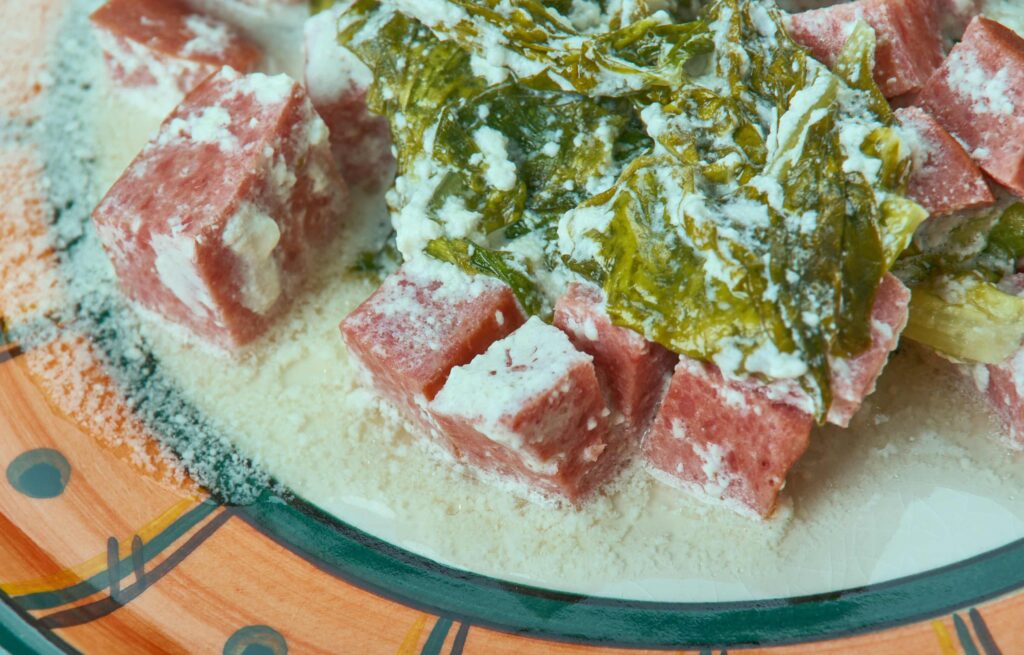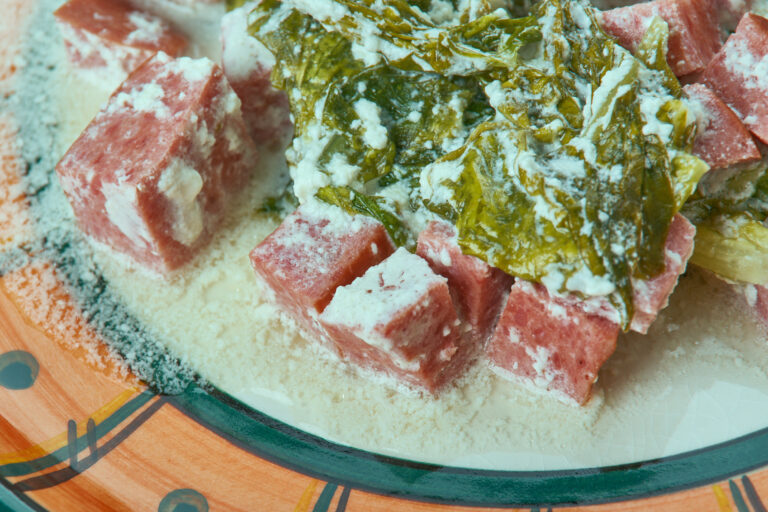
Palusami, a traditional dish of Kiribati, is a culinary delight that has been passed down through generations. This simple yet flavorful dish is deeply rooted in the culture and traditions of the island nation.
The origins of Palusami can be traced back to the indigenous people of Kiribati. It’s a testament to their resourcefulness and deep connection with nature. The main ingredients are readily available on the islands—taro leaves and coconut milk. These humble components come together to create a dish that’s both nourishing and satisfying.
Our team at Remitly created this guide as part of our series that celebrates the cuisine of people around the world.
The Origin of Palusami in Kiribati
In Kiribati, food isn’t just sustenance—it’s an integral part of their cultural identity. Palusami is no exception. This dish has been enjoyed by locals for centuries, its recipe handed down from generation to generation. It’s more than just a meal; it’s a symbol of community and tradition.
The exact origin story of Palusami remains somewhat elusive, much like many ancient recipes. However, it’s widely acknowledged that this dish was born out of necessity and resourcefulness—using what was readily available on the islands.
Ingredients Used in Preparing Palusami
The beauty of Palusami lies in its simplicity—the primary ingredients are taro leaves and coconut milk. Taro leaves are abundant in Kiribati, while coconuts are one of the most versatile fruits on the island.
Taro leaves have a unique flavor profile—they’re slightly sweet but also carry an earthy undertone. When cooked properly, they become tender and absorb flavors well. Coconut milk adds richness to the dish, balancing out the robustness of taro leaves with its creamy sweetness.
Step-by-Step Guide to Making Palusami
Making Palusami involves few steps but requires patience—a reflection perhaps of life on these tranquil islands. First, taro leaves are carefully cleaned then layered into a pot. The coconut milk is then poured over the leaves.
The pot is covered and left to simmer slowly over low heat. This slow cooking process allows the taro leaves to become tender and soak up the flavors of the coconut milk. After several hours, you’re rewarded with a dish that’s creamy, flavorful, and comforting.
Recipe for Traditional Kiribati Palusami
This recipe will guide you through the process of making traditional Kiribati Palusami. It’s a simple dish, but one that requires patience and care to bring out its full flavor.
Ingredients
- 20 large taro leaves
- 2 cups of coconut milk
- Salt to taste
Instructions
- Begin by thoroughly washing the taro leaves. Make sure to remove any dirt or grit.
- Layer the taro leaves in a large pot, ensuring they are evenly spread.
- Pour the coconut milk over the layered taro leaves.
- Add salt according to your preference.
- Cover the pot and let it simmer on low heat for about two hours.
- Check occasionally to ensure that the leaves are becoming tender and absorbing the coconut milk.
- Once cooked, serve hot as a side dish or main course.
Remember, this is a slow-cooked dish—don’t rush it! The flavors develop over time, resulting in a creamy and satisfying meal.
Variations of Palusami Across Kiribati
While the basic recipe for Palusami remains consistent across Kiribati, variations do exist. Some families may add onions or garlic for extra flavor, while others might include fresh fish or meat. There are also variations of this dish in neighboring islands like Tuvalu, and Samoa.
These variations reflect personal preferences and availability of ingredients. Despite these differences, all versions share the same core—taro leaves and coconut milk—and embody the spirit of Kiribati cuisine: simple, natural, and delicious.
How Palusami is Served and Enjoyed
Palusami is typically served as a side dish during meals but can also stand alone as a main course. It pairs well with rice or breadfruit—a starchy fruit common in Pacific Island cuisines.
Eating Palusami isn’t just about nourishment; it’s an experience that brings people together. Sharing this dish fosters a sense of community—a reminder that food is more than just fuel; it’s a way to connect with others.
The Role of Palusami in Kiribati Celebrations
In Kiribati culture, food plays an important role in celebrations—and Palusami is often at the center of these feasts. Whether it’s a wedding, birthday party or community gathering, you’ll likely find this beloved dish on the menu.
Serving Palusami at special occasions signifies respect for tradition—it’s a nod to their ancestors who first created this dish. It also symbolizes hospitality—offering guests something made with care and patience.
Exploring the Global Influence of Kiribati’s Palusami
While Palusami may have originated in Kiribati, its influence has reached far beyond these islands. This dish has found its way into the menus of Pacific Islander communities around the world—each serving as a delicious reminder of their roots.
Despite its global reach, Palusami remains true to its origins—a testament to the enduring appeal of this traditional Kiribati dish. Whether enjoyed on the islands or thousands of miles away, it continues to bring people together—one flavorful bite at a time.
Broader Cuisine of Kiribati
The cuisine of Kiribati is reflective of its island setting—simple yet flavorful dishes made from locally available ingredients.
Seafood in Kiribati Cuisine
Given its location in the Pacific Ocean, seafood plays an integral role in Kiribati cuisine. Fish such as tuna and grouper are often used, either grilled or served raw with coconut cream—a dish known as sashimi.
Fruits and Vegetables
Fruits like bananas, papayas, breadfruit, and coconuts are abundant on these islands and feature prominently in their meals. Root vegetables like taro and sweet potatoes also form part of their staple diet.
Breadfruit Dishes
Breadfruit is another key ingredient in many dishes—it can be roasted, boiled or turned into chips. Its versatility makes it a favored ingredient in Kiribati cuisine.
Traditional Cooking Methods
Traditional cooking methods are still widely used in Kiribati. Earth ovens, known as umw, are often employed for large gatherings and celebrations. Food is wrapped in banana leaves and cooked slowly over hot stones—an age-old technique that imparts a unique flavor to the dishes.
Kiribati cuisine is a testament to the island’s and the region of Micronesia rich cultural and heritage and cuisine. A blend of simplicity, resourcefulness, and respect for nature. Whether it’s the comforting Palusami or the fresh flavors of their seafood dishes, each meal tells a story of tradition and community.
Visit the homepage, download our app, or check out our Help Center to get started.
